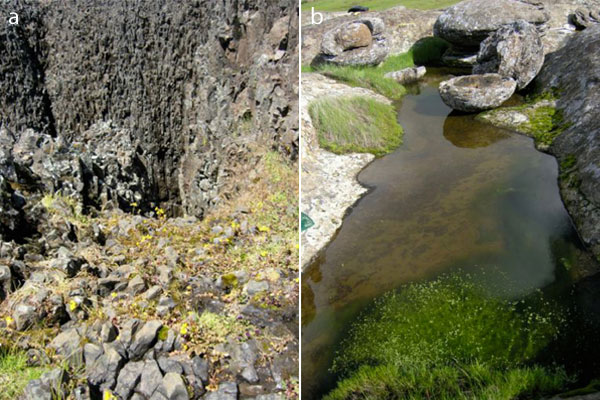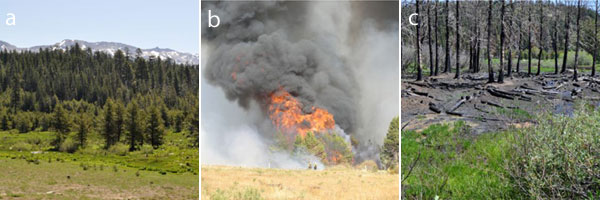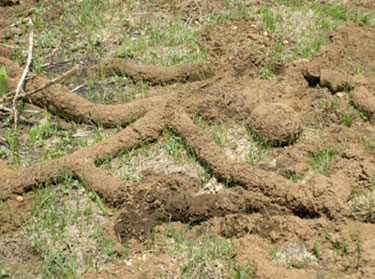« Prev Next »

Over the course of several years, you can return to any location — whether it be the local forest, grassland, pond, abandoned farm (or urban lot), park, or even your backyard — and you are likely to observe changes to the organisms found in the community. New plants may appear and other plants disappear, and these changes may also be reflected in the animal life. These changes may be subtle or obvious, but we can count on communities changing over time in composition, structure, diversity, and productivity. This principle has been exploited by human populations for 1000’s of years, with the manipulation of habitat (e.g., use of fire) to promote the abundance of certain plant and animal species to our benefit. For over a century, ecologists have investigated the nature of these changes in communities, documenting the causes and patterns of change, indentifying mechanisms for change, and developing sets of general principles to explain this change. This change in community composition over time is termed succession. Some definitions also include adjectives for succession (e.g., Odum 1969) that include “orderly”, “directional,” and “stabilizing.” However, these qualifiers have been much disputed and do not accurately represent the process in most cases. Much of the earliest work on succession focused on vegetation, but more recent work has included animal and microbe succession and even the interplay of all organisms, including trophic interactions. An understanding of succession provides insight into community dynamics for ecologists, but also contributes to other fields, including conservation, restoration, and forensics.
The History of the Study of Succession
Henry Cowles’s (1899) dissertation work on sand dunes along Lake Michigan was inspired by earlier European studies describing succession on coastal dunes. While not the first to describe succession, Cowles’s work influenced generations of ecologists by defining laws underlying the patterns of community change. Henry Cowles recognized plant communities as being dynamic, both in species composition and the underlying physical environment, a view that still holds to this day. The basic idea was that plant communities of different ages in sand dunes reflected how the communities changed over time. Cowles, and others since, have used the chronosequence approach to better understand the successional process. Since it would be difficult to follow a successional sequence that lasted decades or centuries, this method replaces a time period by spatial differences (locations of different ages) to infer how succession proceeds (see Johnson & Miyanishi 2008 for a criticism of this approach). The stage in a successional sequence is termed a sere. How this process worked has been a dominant question in the field of ecology, especially plant ecology. Plants are the dominant feature of the landscape, and therefore, received most of the attention over the past century. Ecologists have also identified parallel successional patterns in animals and have even documented animals affecting the direction and rate of succession. The study of succession is now ubiquitous, being investigated in practically all ecosystems (e.g., aquatic, marine) with practically all taxonomic groups (e.g., fish, insects, protozoans, rodents).
Types of Succession
The successional process has been categorized into two types, based on the properties of the habitat on which it occurs. Primary succession, the colonization of habitats devoid of life, occurs in a new habitat with no vegetation prior to succession. These new land surfaces are caused by volcanism, dune and barrier island formation, and glaciation, which require species to colonize the area from outside (Figure 1). The rate of primary succession tends to be slow because of the arduous process of soil development that is required by the activities of organisms and abiotic factors. For example, rock locations tend to be colonized by lichens, which, in concert with physical processes (e.g., wind and rain), will develop the substrate in a way that allows the persistence of other colonists (e.g., bryophytes and vascular plants). Secondary succession will occur in habitats following a disturbance, which leaves seeds, spores, or the subterranean portions of plants present (Figure 2). A disturbance is any event, usually abiotic, in the environment that shifts a community from it equilibrium. (Figure 3). This event is an irregular occurrence that can include the removal of biomass or mortality. Disturbances include fire, severe storms or droughts, landslides, mammal burrowing, flooding, and tree falls, which can change the availability of resources and the composition and densities of individuals in the community. A habitat is readily accessible to many of the species already present, and those colonizing, and therefore occurs at a faster rate than primary succession. Another difference is the degree of soil development: in primary succession, it can take thousands of years, while it is usually fully developed in secondary succession. The initial inhabitants (early serial stage) are termed pioneer community and the final stage is described as the climax community.

Models of Succession
Several models have been developed that describe and make predictions about the successional process. One of the most influential was Frederic Clements’ work from early in the twentieth century (e.g., Clements 1936). Succession was viewed as a deterministic and orderly sequence of serial stages that ended with the climax community. In this view, each stage was composed of a group of species viewed as a super-organism working together and developing on a site that was then replaced by another stage. Ultimately, succession arrived at a climax community, which characterizes the habitat and was viewed as the “expression of the climate”. In contrast, Henry Gleason presented a different view of succession that emphasized individualistic traits (abiotic tolerances and dispersal) of species and their interactions with the environment (Gleason 1926). Species occur together in a location as the result of their abiotic tolerances (niche requirements), not because they are part of an integrated “superorganism.” This perspective viewed succession as less deterministic and more reliant on chance dispersal events. One of the consequences is the potential for different successional trajectories resulting in alternative climax communities.

Clements’s erroneous views pervaded ecology for decades, but this began to erode with early criticisms by notable ecologist Arthur Tansley (1935) and research that revived Gleason’s individualistic view during the 1950s. This work included Robert Whitaker’s gradient and John Curtis’ continuum approaches, which illuminated the view regarding individualistic species segregation along environmental gradients that did not reflect consistent associations predicted by Clements. During this time, the imprint of Clements was also seen in developments of ecological views of succession (e.g., Egler 1954). Eugene Odum (1969) presented an ecosystem view of succession within a Clementsian successional paradigm. It presented expectations about how energy, biogeochemical processing, life history, selection pressure (i.e., r- and K-selection), abundance, and community structure change over time. Finally, Connell & Slatyer (1977) reformulated many of the models and ideas about succession. They presented three models that described mechanisms and hypotheses about how succession proceeded. All three assumed that the initial composition of the community was determined by early pioneer species that produced numerous seeds, germinated early, and grew quickly. How the models differed was how succession proceeded. Succession could occur through facilitation, whereby early successional species modify the environment for later species that replace them (see Clements and Egler’s relay floristics). The second pathway, tolerance, is driven by life-history characteristics whereby later successional species grow more slowly and eventually replace early successional species. Lastly, the inhibition model finds early colonists dominating until a disturbance or mortality removes them and the longer-lived late successional species replacing them. David Tilman (1985) used the resource-ratio theory to present another mechanistic view of succession. He made specific predictions about how changes in the ratios of resources (e.g., light or nitrogen availability) over time can shift community composition, because species specialized on specific proportions of those resources. The current view acknowledges the complex array of factors and contingencies that influence succession. The models (e.g., Markov Models) and methods have become more sophisticated with integrating many contributing factors, including (but not limited to) spatial processes (e.g., dispersal), life histories and species traits, complex species interactions (e.g., direct and indirect), environmental gradients, and disturbance characteristics.
Factors Affecting Change

Many of the concepts and processes addressed within the framework of “succession” are paralleled in the field of community “assembly” (see MacIntosh 1999, Young et al. 2001); indeed they share more similarities than differences in making predictions about how communities change through time in response to dispersal, biotic interactions, and abiotic factors. Many of the differences between these two approaches are artificial constructs of the field of ecology, but attempts to integrate them have only occurred recently (Young et al. 2001, Suding et al. 2004). Interestingly, both approaches have been employed to guide habitat restoration and land management (Young et al. 2001, Suding et al. 2004). For example, both paradigms address the roles of dispersal and species interactions in determining the composition of communities over time. Future work should continue to synthesize these two bodies of theory.
References and Recommended Reading
Clements, F. E. Nature and structure of the climax. Journal of Ecology 24, 252-284 (1936).
Connell, J. H. & Slatyer, R. O. Mechanisms of succession in natural communities and their role in community stability and organization. American Naturalist 111, 1119-1144 (1997).
Cowles, H. C. The ecological relations of vegetation on the sand dunes of Lake Michigan. Botanical Gazette 27, 95-117, 167-202, 281-308, 361-391 (1899).
Egler, F. E. Vegetation science concepts I. Initial floristics composition, a factor in old-field vegetation development. Vegetation 4, 412-417 (1954).
Gleason, H. A. The individualistic concept of the plant association. Bulletin of the Torrey Botanical Club 53, 7-26 (1926).
MacIntosh, R. P. The succession of succession: a lexical chronology. Bulletin of the Ecological Society of America 80, 256-265 (1999).
Odum, E. P. The strategy of ecosystem development. Science 164, 262-270 (1969).
Johnson, E. A. & Miyanishi, K. Testing the assumptions of chronosequences in succession. Ecology Letters 11, 419-431 (2008).
Suding, K. N., Gross, K. L., et al. Alternative states and positive feedbacks in restoration ecology. Trends in Ecology and Evolution 19, 46-53 (2004).
Tansley, A. G. The use and abuse of vegetational concepts and terms. Ecology 16, 284-307.
Tilman, D. The resource-ratio hypothesis of succession. American Naturalist 125, 827-852 (1985).
Wilson, J. B., Gitay, H., et al. Egler's concept of 'Initial Floristic Composition' in succession: ecologists citing it don't agree what it means. Oikos 64, 591-593 (1992).
Young, T. P., Chase, J. M., et al. Community succession and assembly: comparing, contrasting and combining paradigms in the context of ecological restoration. Ecological Restoration 19, 5-18 (2001).






























